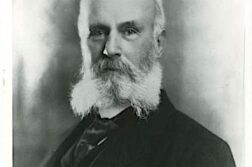IN THE 1930s AND ’40s, George Platt Lynes was one of the best-known photographers in New York City. His portraits and fashion photographs were published in such national magazines as Town & Country, Vogue, and Harper’s Bazaar. Today, he is best remembered for a vast archive of male nude photography that has since the 1970s been increasingly “rediscovered” by a new generation of queer artists and curators.
Over seventy years after Lynes’ death at the age of 48, Allen Ellenzweig has written the first book-length biography of the artist, George Platt Lynes: The Daring Eye. Ellenzweig, who is also the author of The Homoerotic Photograph: Male Images from Durieu/Delacroix to Mapplethorpe (1992), offers a richly researched portrait of the circle of artists and writers who created a queer, cosmopolitan world in mid-century America.
This interview was conducted by way of e-mail relay last December. — JP
James Polchin: So who was George Platt Lynes, and what motivated you to research and write his biography?

Allen Ellenzweig: Lynes was a photographer whose portraits were of leading writers, artists, and classical dancers—and, quite significantly, the nude figure, especially the male nude. From the start, he set his sights on photographing prominent writers in English and French who dared to deal with sexual activities. Jean Cocteau, Colette, André Gide, and the expatriate American writer Gertrude Stein were early subjects for his camera. Stein became his most important mentor in his early years when, briefly studying in Paris to prepare for entry into Yale, he imagined he would make his living as a man of letters. While he eventually made his living as a fashion photographer in the Condé Nast publishing empire, the male nude photographs were an obsession without commercial recompense. They were too frank for American publications and forbidden transport by the U.S. Post Office. However, when social mores and obscenity statutes relaxed, this work was exhibited and then published. Lynes’s work with the male nude has influenced gay photographers of the post-Stonewall generation—men like Robert Mapplethorpe, Herb Ritts, and Duane Michals.







